Deposit LDP
4. Carmarthenshire - Strategic Context
4.1 Carmarthenshire is positioned at the heart of south west Wales. It enjoys strong links to wider economies both to the east and across into England, but also west to Pembrokeshire and Ireland as well mid and north Wales. Carmarthenshire boasts a dynamic economic base, reflecting its strong employment centres as well as a having an important rural economy. The County has been successful in attracting investment, and places regeneration as its number one corporate priority.
4.2 The County is characterised by its diverse towns and villages, large employment parks, regional retail centres, prominent rural economy, and attractive upland, estuarine and coastal landscapes. The Welsh language and culture are also important aspects of Carmarthenshire's identity and character with the County prominent as a heartland for Welsh speakers.
4.3 Within the County there are key economic drivers including the investments at Cross Hands in relation to the food park and the Cross Hands East employment site. The signing of the £1.3billion city deal in 2017 and the progress in delivering the associated projects - Yr Egin Creative Cluster in Carmarthen and the Llanelli Well-being and Life Sciences project - reinforces Carmarthenshire's strategic and regional importance.
Carmarthenshire is a County with a diverse character with the agricultural economy and landscape of the rural areas juxtaposed with the urban and post-industrial south-eastern area.
4.4 As a primarily rural County, the population density is low at 78 persons per sq. kilometre, compared with 140 persons per sq. kilometre for Wales as a whole. This sparsity of population is reflective of the largely rural communities as opposed to the south and east of the County where 65% of the population reside on 35% of the land.
4.5 The main urban centres of the County include Llanelli, Carmarthen and Ammanford / Cross Hands. Carmarthen due to its central geographic location typically serves the needs of the County's rural hinterland as well as the wider region in aspects such as retailing. Both Llanelli and Ammanford / Cross Hands have a rich industrial heritage but remain important contributors to their wider communities acting a focal points for employment and homes.
4.6 The County has a large number of settlements reflecting the size and diversity of the County. These vary in size and role with many often making notable contributions to the needs and requirements of their community and the surrounding area. A number of settlements and villages are self-sufficient in terms of facilities and services, often fulfilling a wider service role. However, other smaller settlements lack services and facilities. The needs of residents in these latter areas are typically met by main centres and in some instances the other serviced smaller settlements.
Well-being and Sustainable Development
4.7 The Plan has been prepared with full consideration of the content of the Well-being of Future Generations Act and the Council's duties to work towards Wales' seven wellbeing goals and the need to contribute to sustainable development and management of natural resources (see Figure 1).
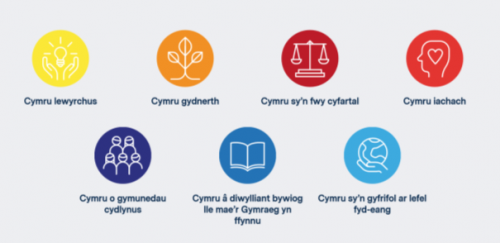
Figure 1: Seven Well-being Goals
4.8 The Well-being of Future Generations Act also establishes 'Five Ways of Working' which public bodies need to demonstrate they have carried out in undertaking their sustainable development duty.
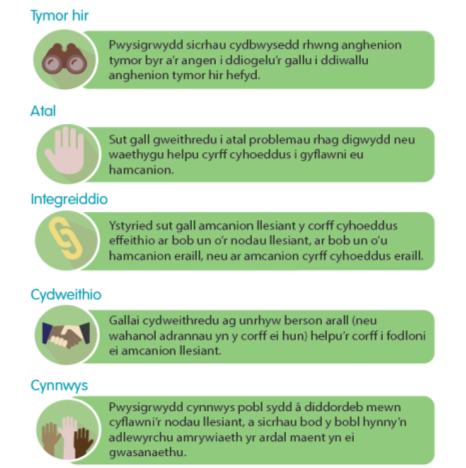
Figure 2: Five Ways of Working
4.9 PPW identifies that the plan-led approach is the most effective way to secure sustainable development (through the planning system) and it is essential that plans are adopted and kept under review. In this respect legislation secures a presumption in favour of sustainable development in accordance with the development plan unless material considerations indicate otherwise to ensure that social, economic, cultural and environmental issues are balanced and integrated.
4.10 As referenced above the Deposit LDP has been subject to Sustainability Appraisal incorporating Strategic Environmental Assessment (SEA) with the purpose of improve the extent to which the Plan achieves and contributes to sustainable development, in so far as is possible through the land use planning system. The SA has been an iterative process throughout the Plan's preparation and this is reflected in the Plan's growth strategy, policies and proposals.
4.11 Sustainable development is development that meets the needs of the present, without compromising the ability of future generations to meet their own needs. The concept can be interpreted in many ways, but at its core is an approach to development that looks to balance different, often competing, needs against an awareness of environmental, social, economic and cultural limitations.
4.12 Although environmental considerations are central to the principle of sustainable development, it is also about ensuring a strong, healthy and just society, and meeting the needs of all people now and in the future. This includes promoting personal well-being, social cohesion and creating equal opportunities.
4.13 The Well-being of Future Generations Act places a duty on public bodies to carry out sustainable development and requires an improvement in the delivery of all four aspects of well-being: social, economic, environmental and cultural.
4.14 The Carmarthenshire Well-being Assessment (March 2017) looked at the economic, social, environmental and cultural wellbeing in Carmarthenshire through different life stages and provides a summary of the key findings. The findings of this assessment form the basis of the objectives and actions identified in the Well-being Plan for Carmarthenshire. The Assessment can be viewed via the following link: www.thecarmarthenshirewewant.wales
The Carmarthenshire Well-being Plan outlines the Public Service Board's local objectives for improving the economic, social, environmental and cultural well-being of the County and the steps it proposes to take to meet them. Carmarthenshire's Well-being Plan covers a period between 2018-2023, with objectives and actions identified to look at delivery on a longer term basis of up to 20-years.
4.15 The Carmarthenshire Well-being Plan will focuses on the delivery of four objectives:
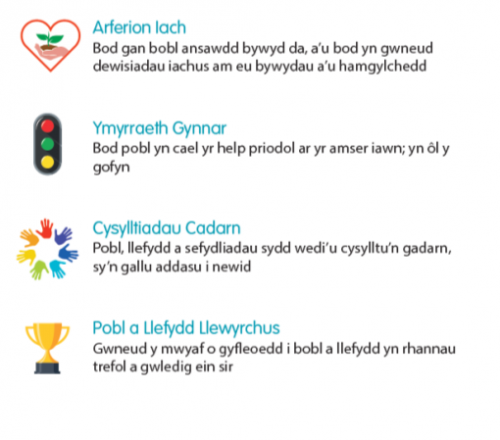
Figure 3: Carmarthenshire Well-being Plan: Four Objectives
4.16 The Plan sits within the framework of other relevant National Planning Policy and Guidance, and other regional and local policies and strategies. These are set out in the Appendices to the Plan.
4.17 Of particular note is Planning Policy Wales (PPW) Edition 10 which sets out the national land use planning policies of the Welsh Government. It is supplemented by Technical Advice Notes (TANs); procedural advice given in circulars; and policy clarification letters.
4.18 National Planning Policy and Guidance is not repeated within the policies of the plan, but must be taken into account when developing proposals and in the consideration of planning applications.
4.19 The Deposit LDP has regard to the Wales Spatial Plan (WSP) which provides an overarching policy context for spatial planning and development in Wales. First published in 2004 and updated in 2008, the WSP sets out to ensure that proposals throughout Wales are integrated and sustainable with individual actions being supportive of each other and in compliance with the shared vision for the area.
4.20 Carmarthenshire is situated within three areas identified in the WSP:
- Pembrokeshire - The Haven;
- Swansea Bay - Waterfront and the Western Valleys; and,
- Central Wales.
4.21 The WSP remains a material consideration in the preparation of the LDP.
4.22 However, it is referenced within the context of the preparation of the emerging National Development Framework (NDF) for Wales which will replace the WSP. In this respect it is noted that the consultation on the Draft NDF will close on the 1st November 2019. The adopted NDF is scheduled for publication in September 2020 and its content will be further considered as the Plan progresses towards adoption.
4.23 The plan has and will continue to take account of the strategic regional objectives both as currently set out within the WSP but also within the emerging NDF. In this respect both align with the strategic approach set out through the Swansea Bay City Region which was launched in 2013.
4.24 The creation of the Swansea Bay City Region brought together a wide, diverse and contrasting area with the focus on driving investment and job creation opportunities. This was further progressed through the signing of the £1.3billion city deal in 2017 further reinforcing the regions ambitions and Carmarthenshire's strategic and regional importance.
The Swansea Bay City Deal is being led by the four regional local authorities - Carmarthenshire Council, Swansea Council, Neath Port Talbot Council and Pembrokeshire Council - together with the Abertawe Bro Morgannwg and Hywel Dda University Health Boards, Swansea University, the University of Wales Trinity Saint David, and private sector partners.
4.25 The total investment package is made up of £241 million UK and Welsh Government funding, £396 million other public sector investment, and £637 million from the private sector. Over the next 15 years, the City Deal will seek to boost the regional economy by £1.8bn and generate almost 10,000 new, high-quality jobs.
4.26 The City Deal projects are based on key themes of Economic Acceleration, Life Science and Well-being, Energy, and Smart Manufacturing. Each project will be supported by world class digital infrastructure and a Skills and Talent initiative that will give local people a pathway to access the jobs that will be created.
4.27 The ambitions nature within the region and of that of the City Deal are reflected within the Council's own strategic outlook. In this respect the Councils regeneration plan seeks to provide a strategic framework for the delivery of regeneration projects across the County building on the partnership led approach in creating economically vibrant communities[14].
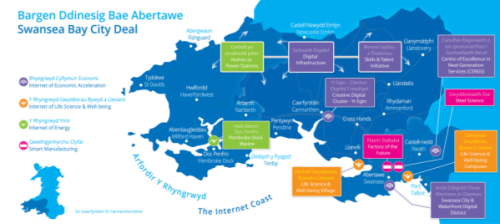
Figure 4: Swansea Bay City Deal
4.28 Carmarthenshire is home to around 6% of Wales' total population with 186,452 people. Since 2001, the County has seen its population grow by 12,800 people, a 7.4% increase in 16 years. The highest level of population growth was recorded before 2008, with the years since showing a lower level of growth.
4.29 The main factor influencing population change in Carmarthenshire since 2001/2002 has been through inward migration, where more people have come into the County than have left. The population growth is also considered against the County's natural change which has seen the number of deaths exceeding births each year since 2001/2002.
4.30 Migration patterns out of Carmarthenshire has seen a large number of the 15-19 age group leave the County. This largely reflects students leaving the County for higher education opportunities. There is an increase of people moving into the County within the 30-44 young family age group and the 0-14 year age group. There is also an increase in the over 65 age group which has contributed to Carmarthenshire's ageing population profile.
4.31 Since the inception of the Local Development Plan process in Wales, the Welsh Government has published four population and household projections. The 2006 and 2008 WG based projections have been influenced by high net migration statistics (internal and international) which identified significant growth for Carmarthenshire (as reflected in the Adopted LDP). However the WG 2011 and 2014-based projections reflected a post-recession phase which indicated a lower in-migration trend which has translated into a much lower anticipated household growth requirement for Carmarthenshire.
4.32 The Welsh Government 2014-based household projections estimates that average household sizes are not decreasing as quickly as previous projections suggested. This higher estimate of household sizes coupled with the changes in population growth within the County has resulted in a much lower anticipated household requirement from that identified in the existing adopted LDP. This revised LDP seeks to place these projections within a Carmarthenshire context and develop a set of projections for change and growth that reflect the needs and aspirations for Carmarthenshire and its communities.
4.33 There are significant variations across the County in terms of social indicators of deprivation, including access to health, education and community services and facilities; and housing quality. Some communities lack a social hub and/or key facilities to act as a community focus. Others have a range of services and facilities that contribute to vibrant community life. A more equitable distribution is needed. This to some extent reflects the rural character of the County. In this context many rural communities access facilities in nearby settlement or higher order centres. This is reflective of a pattern of rural life now common across Wales. This need to reflect this pattern and recognise the need to sustain such rural communities is a key factor across the County and within this plan.
4.34 With 78,048 Welsh speakers amongst its population, Carmarthenshire is the county with the highest number of Welsh speakers in Wales and has the fourth highest proportion of Welsh speakers at 43.9% (2011 Census data). There is therefore a clear strategic focus on the central role it plays within Carmarthenshire and its communities.
4.35 The image below shows the distribution of Welsh speakers per Electoral ward as recorded in the 2011 Census data. Whilst there is no obvious concentration of Welsh speakers in any particular area, it is apparent that a number of wards with a higher proportion of Welsh speakers are located in the Amman and Gwendraeth Valleys which are located in the cluster identified as the 'Amman and Upper Gwendraeth'.
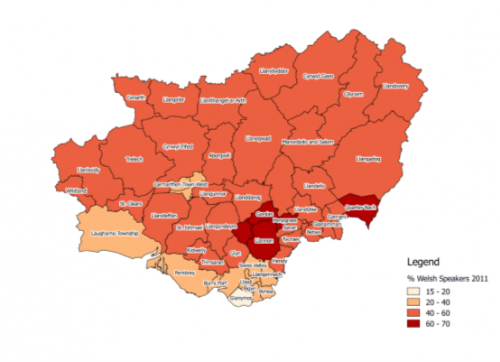
Figure 5: % of Welsh speakers in Carmarthenshire Electoral Wards (Census 2011 figures)
4.36 It is however noted that the proportion of Welsh speakers in Carmarthenshire has been steadily declining since the turn of the last century and the decline in proportion of Welsh speakers in Carmarthenshire has been recorded by every Census since 1901. More recently, during the period between the 1991 and 2011 Censuses, the percentage of Welsh speakers in Carmarthenshire has decreased from 54.9% to 43.9%. Consequently, and given the Welsh languages importance, including to the social fabric, across our communities it is important that it is recognised and safeguarded.
4.37 The Council's corporate ambitions for growth and regeneration as expressed through its regeneration strategy and the Swansea City Deal indicates a potential for a minimum of 5,295 new jobs. This reflects an ambitious County strategically positioned at the gateway to west wales and central to the City Deal.
4.38 Indeed the future economic development of the County should be viewed in the wider context. The Swansea Bay City Deal was signed in 2017, securing £1.3 billion for Swansea, Carmarthenshire, Neath Port Talbot and Pembrokeshire councils. It is anticipated that the deal will transform the economic landscape of the area, boost the economy and generate almost 10,000 new jobs over the next 15 years.
4.39 This growth potential is also in part recognised within the emerging NDF and the overlap into the south west of the County of the South West National Growth Area with its focus on Swansea Bay and the Llanelli Area as well as the secondary town of Carmarthen[15].
4.40 A buoyant rural economy is needed to support the overall growth of the County, and to help sustain community life. Sustainable tourism provides a key means of delivering this growth and providing good quality local jobs, as do the opportunities presented through farm diversification schemes.
4.41 Employment land opportunities are required for a range of potential enterprises and investments, from small-scale local concerns to large-scale strategic development areas that may appeal to inward investors. Such opportunities can be delivered through existing employment land and through new sustainable allocations in appropriate locations.
4.42 With the over-representation of public sector jobs within the county, the additional jobs required over the Plan period will need to be delivered through development that promotes and diversifies growth across sectors, and re-orientates the economy towards high quality, skilled and knowledge based sectors.
4.43 The LDP invitation for candidate sites saw the submission of over 40 sites for employment or mixed use. Whilst some of these are allocations in the first LDP and have been carried forward into the Revised LDP, others might be appropriate as unallocated 'reserve' sites which could, where they are appropriate and sustainable, potentially serve as locations for future employment and job creation.
4.44 The richness of Carmarthenshire's natural and cultural environment is an important spatial consideration in planning for the future of the County, particularly in terms of the potential for growth and the siting of development. Carmarthenshire is justly renowned for its magnificent coast, quiet estuaries, steep wooded valleys and rugged uplands. Throughout much of the rest of the county there is a patchwork of woodlands and fields, bounded by the hedge-banks that are frequently of historic importance. The sea and seabed around the Carmarthenshire coast are also rich in species, some of which are of considerable economic importance. This natural beauty of the county is a major factor on which the local tourism and recreation industries depend. Biodiversity is therefore fundamental to the physical, economic and spiritual well-being of all who live and work in Carmarthenshire.
4.45 The local plan area includes sites designated at the international level to protect and enhance important habitats and species, as well as striking landscapes and distinctive historic towns and villages. There are a number of designated sites for nature conservation and biodiversity importance, including 8 Special Areas of Conservation (SAC), 3 Special Protection Areas (SPA), 1 Ramsar site, 81 Sites of Special Scientific Interest (SSSI), 5 National Nature Reserves (NNR), 5 Local Nature Reserves (LNR) and 7 registered landscapes.
4.46 SSSI's alone cover some 17,088 Ha, and range in size from small fields to large areas of mountain sides and long rivers. They include habitats such as ancient woodland, flower-rich meadows, wetlands as well as disused quarries and support plant and animal species which are not often seen in the wider countryside.
4.47 The importance of the County's built heritage is borne out by the 27 conservation areas, 366 Scheduled Ancient Monuments (ranging from Prehistoric to post- Medieval/Modern features of cultural historic interest) and the large number of listed buildings.
4.48 Agriculture in Carmarthenshire dominates the rural landscape with the agricultural industry and in particular dairy and sheep farming establishing the County as one of the most important agricultural areas in Wales. Some 203,700 ha of land within Carmarthenshire is classified as agricultural land with the majority classified as grade 3a and 4 with a small tranche of grade 2 land in the south-east of the County.
4.49 Carmarthenshire is well located on the strategic highway network with connections to the west provide links to the Irish ferry ports, which with the M4 forms part of the Trans-European Network. This east-west link is further emphasised by the West Wales railway line which extends from Swansea (and the wider rail network) through to Pembrokeshire via Carmarthen and Llanelli. The West Wales line also forms part of the Trans-European Network linking to and from the Irish Ferry Ports in Pembrokeshire. The Heart of Wales railway line extending from Swansea through eastern parts of the County through to Shrewsbury offers additional transport benefits albeit based on a limited service.
4.50 The County is also served by a number of A-roads as well as numerous B-classified roads each representing important components of the highway network. Our principal highway network includes the A48 trunk road leading to and from the M4 motorway with its connections through South East Wales and beyond. Whilst the A40 and A483 trunk roads connect to Mid and North Wales as well as to the Midlands and the North of England. Access into Central and onwards into North Wales is provided via the A484 and the A485.
4.51 The following illustrates the nature of the road network including the level of provision which is met through B and lower classification roads. This in part reflects of the rural extent of the County and emphasises the challenges to delivering a sustainable integrated strategy for the area.
|
Carmarthenshire Road Network – Road Length (Km) |
|
|
Motorway (M4) |
5 |
|
Class A (Trunk) |
147 |
|
Class A (County) |
247 |
|
Class B and C |
1,579 |
|
Minor Surfaced |
1,496 |
Table 1
4.52 The area is generally well served by public transport through the bus network, albeit with the level and frequency of service subject to variation dependent upon location and destination. In addition, a number of services operate on a 'Hail-&-Ride' basis in rural areas and 'Bwcabus' in the Teifi Valley, such services offer additional accessibility benefits to such areas.
[14] A strategic regeneration plan for Carmarthenshire 2015-2030 – Transformations - https://www.carmarthenshire.gov.wales/media/1212060/strategic-regeneration-plan-for-carmarthenshire-2015-2030-pdf.pdf
[15] National Development Framework 2020 – 2040 (Consultation Draft)
